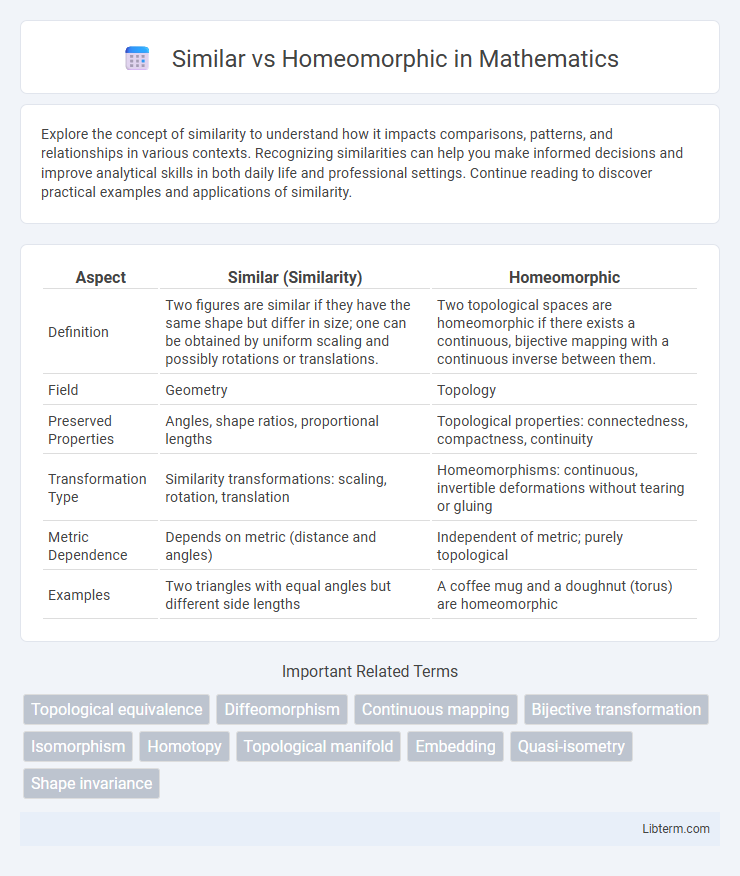Explore the concept of similarity to understand how it impacts comparisons, patterns, and relationships in various contexts. Recognizing similarities can help you make informed decisions and improve analytical skills in both daily life and professional settings. Continue reading to discover practical examples and applications of similarity.
Table of Comparison
| Aspect | Similar (Similarity) | Homeomorphic |
|---|---|---|
| Definition | Two figures are similar if they have the same shape but differ in size; one can be obtained by uniform scaling and possibly rotations or translations. | Two topological spaces are homeomorphic if there exists a continuous, bijective mapping with a continuous inverse between them. |
| Field | Geometry | Topology |
| Preserved Properties | Angles, shape ratios, proportional lengths | Topological properties: connectedness, compactness, continuity |
| Transformation Type | Similarity transformations: scaling, rotation, translation | Homeomorphisms: continuous, invertible deformations without tearing or gluing |
| Metric Dependence | Depends on metric (distance and angles) | Independent of metric; purely topological |
| Examples | Two triangles with equal angles but different side lengths | A coffee mug and a doughnut (torus) are homeomorphic |
Understanding Similarity in Mathematics
Similarity in mathematics refers to the relationship between two shapes that have the same form but different sizes, preserving angles and proportional sides. It is characterized by a similarity transformation, including scaling, translation, rotation, or reflection, which maintains the geometric properties without altering the shape's fundamental structure. Unlike homeomorphism, which involves continuous deformation preserving topological properties, similarity specifically preserves metric properties like angles and ratios of lengths.
Defining Homeomorphism in Topology
Homeomorphism in topology is a continuous, bijective function between two topological spaces with a continuous inverse, preserving topological properties. Unlike similarity, which involves geometric transformations like scaling and rotation preserving shape, homeomorphism focuses on preserving the intrinsic topological structure. Homeomorphic spaces are essentially topologically equivalent, meaning one can be deformed into the other without tearing or gluing.
Key Differences Between Similar and Homeomorphic
Similar structures share geometric properties such as shape and proportional dimensions, characterized by a consistent scale factor between corresponding elements. Homeomorphic spaces maintain topological equivalence, preserving properties like continuity and connectivity without regard to distance or angles. The key difference lies in similarity emphasizing metric properties while homeomorphism focuses on continuous deformation without tearing or gluing.
Criteria for Similar Figures
Similar figures have congruent angles and proportional corresponding side lengths, ensuring uniform scaling without altering shape. The key criteria for similarity include equal corresponding angles and the ratio of corresponding sides being constant throughout the figures. Homeomorphic figures, by contrast, emphasize topological equivalence, allowing continuous deformation without tearing or gluing, focusing on connectivity rather than metric properties.
Criteria for Homeomorphic Spaces
Homeomorphic spaces require a continuous, bijective map with a continuous inverse, preserving topological properties like connectedness and compactness. Similar spaces, often in geometry, focus on shape and size relationships through scaling, ignoring topological equivalences. The key criterion for homeomorphism is the existence of a homeomorphism that maintains the intrinsic topological structure rather than metric properties.
Examples of Similar Figures
Similar figures share the same shape but differ in size, such as two triangles with proportional corresponding sides and equal corresponding angles. An example includes two rectangles where one is a scaled version of the other, maintaining angle congruency and side ratios. Unlike homeomorphic figures, which focus on topological equivalence, similarity emphasizes geometric properties like angle measure and side proportionality.
Examples of Homeomorphic Spaces
Homeomorphic spaces are topological spaces that can be continuously transformed into each other without cutting or gluing, exemplified by a coffee cup and a donut, which both have one hole and are topologically equivalent. Other examples include a sphere and an ellipsoid, as well as a Mobius strip and a twisted band, which share essential topological properties despite differing geometrically. Similar spaces, on the other hand, involve metric-preserving transformations like scaling, which do not necessarily imply topological equivalence.
Applications of Similarity and Homeomorphism
Similarity transformations find extensive applications in computer graphics, robotics, and image processing by preserving shapes while enabling scaling, rotation, and translation of objects for pattern recognition and object analysis. Homeomorphisms play a critical role in topology and complex analysis, where continuous deformations without tearing or gluing facilitate the classification of topological spaces and study of properties invariant under continuous transformations. Both concepts are fundamental in data analysis, with similarity aiding in feature extraction and clustering, and homeomorphism supporting advanced spatial data modeling and morphing techniques.
Common Misconceptions Explained
Similarity in mathematics refers to figures having the same shape but possibly different sizes, characterized by proportional side lengths and equal angles, whereas homeomorphism in topology means a continuous deformation between spaces without tearing or gluing, preserving topological properties. A common misconception is that similar shapes are always homeomorphic; however, similarity concerns geometric properties, while homeomorphism addresses topological equivalence regardless of metric properties. Understanding that similarity depends on rigid geometric criteria and homeomorphism on flexible topological transformations clarifies their distinct applications and prevents conflation.
Summary of Similarity vs Homeomorphism
Similarity refers to a geometric transformation where two shapes share the same form but differ in size, preserving angles and proportional distances through scaling, rotation, and translation. Homeomorphism is a topological concept involving a continuous deformation between spaces that preserves connectivity and properties like compactness and connectedness, but not necessarily geometric measurements. Summary-wise, similarity maintains precise shape proportions and angles within Euclidean geometry, while homeomorphism focuses on the intrinsic topological equivalence without concern for exact metric properties.
Similar Infographic

 libterm.com
libterm.com